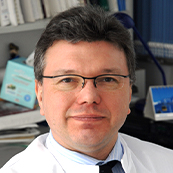Bedeutung thrombophiler Risikofaktoren für das Erst- und Rezidivthromboserisiko
Zusammenfassung
Die vorliegende Übersicht zeigt die klinische Relevanz thrombophiler Risikofaktoren hinsichtlich ihres Einfl usses auf das absolute Risiko für die Entstehung einer Erst- oder Rezidivthrombose. Im Gegensatz zu den in Publikationen üblicherweise angegebenen relativen Risiken erlauben Informationen über das absolute Thromboserisiko dem behandelnden Arzt eine individuelle NutzenRisiko-Abwägung gegenüber dem absoluten Blutungsrisiko unter Antikoagulation. Aufgrund von schweren Blutungskomplikationen unter oraler Antikoagulation resultiert für Erstthrombosen unter Risikoexposition (z.B. Operation, hormonelle Kontrazeptiva) in der Regel keine langfristige orale Antikoagulation. Aus hämostaseologischer Sicht besteht eine zeitlich unbegrenzte, jedoch regelmäßig zu prüfende Indikation zur oralen Antikoagulation bei niedrigem und mittlerem Blutungsrisiko (1-3% pro Jahr) bei spontaner proximaler Erstthrombose und kombinierten oder schweren thrombophilen Defekten (z.B. homozygoter Faktor V-Leiden, Antithrombin-Mangel), die das Rezidivrisiko mehr als verdoppeln (d.h. von 4% ohne thrombophile Risikofaktoren auf ≥8% pro Jahr).
This review presents a risk-adapted treatment concept based on absolute risks of thrombosis and bleeding. Hereditary and acquired thrombophilic risk determinants increase the risk of fi rst and recurrent venous thromboembolism (VTE) and absolute risks associated with thrombophilic risk factors in comparison with absolute risks of severe bleeding allow an individual risk-benefi t. In case the VTE was provoked by a reversible risk factor such as surgery or oral contraceptives, the risk of recurrence is low and three months of oral anticoagulation appears to be adequate. Indications for an indefi nite oral anticoagulation are less well defi ned in international guidelines. In favor of an indefi nite oral anticoagulation (1-3% bleeding risk per year) are two or more idiopathic events, antiphospholipid syndrome, malignancy, and combined or severe thrombophilic defects like antithrombin defi ciency or homozygous factor V Leiden in patients with a fi rst idiopathic VTE (risk factors increase thrombosis risk from 4% to ≥8% per year).
Alle Ausgaben
durchsuchen
Können Sie immer hier
am Seitenende.



